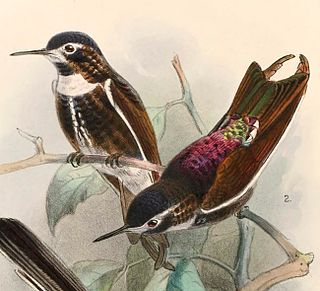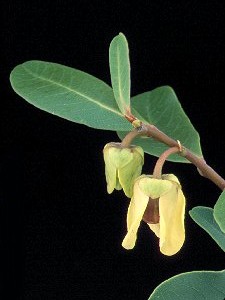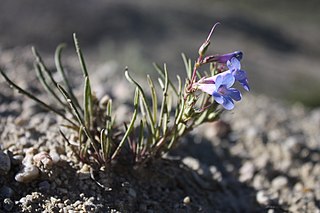
Aconitum noveboracense, also known as northern blue monkshood or northern wild monkshood, is a flowering plant belonging to the buttercup family (Ranunculaceae). Members of its genus (Aconitum) are also known as wolfsbane.

In zoology, a palynivore /pəˈlɪnəvɔːɹ/, meaning "pollen eater" is an herbivorous animal which selectively eats the nutrient-rich pollen produced by angiosperms and gymnosperms. Most true palynivores are insects or mites. The category in its strictest application includes most bees, and a few kinds of wasps, as pollen is often the only solid food consumed by all life stages in these insects. However, the category can be extended to include more diverse species. For example, palynivorous mites and thrips typically feed on the liquid content of the pollen grains without actually consuming the exine, or the solid portion of the grain. Additionally, the list is expanded greatly if one takes into consideration species where either the larval or adult stage feeds on pollen, but not both. There are other wasps which are in this category, as well as many beetles, flies, butterflies, and moths. One such example of a bee species that only consumes pollen in its larval stage is the Apis mellifera carnica. There is a vast array of insects that will feed opportunistically on pollen, as will various birds, orb-weaving spiders and other nectarivores.

Ramonda myconi, the Pyrenean-violet or rosette mullein, syn. R. pyrenaica, is a species of flowering plant in the family Gesneriaceae, which is a relictual endemite of shady, rocky places in the Pyrenees and north eastern Spain. It is a rosette-forming evergreen perennial growing to 10 cm (4 in) high by 20 cm (8 in) broad, with oval, crinkled leaves. Five-petalled purple flowers with prominent yellow anthers appear on leafless stems in spring.

Platanthera yadonii, also known as Yadon's piperia or Yadon's rein orchid, is an endangered orchid endemic to a narrow range of coastal habitat in northern Monterey County, California. In 1998 this plant was designated as an endangered species by the United States government, the major threat to its survival being continuing land development from an expanding human population and associated habitat loss. One of the habitats of Yadon's piperia, the Del Monte Forest near Monterey, California, is the subject of a federal lawsuit, based upon endangerment of this organism along with several other endangered species.

Theodor Heinrich Hermann von Heldreich was a German botanist born in Dresden.

The purple-backed sunbeam is a bird species in the family Trochilidae. It is found only in Peru.

Mount Olympus is the highest mountain in Greece. It is part of the Olympus massif near the Thermaic Gulf of the Aegean Sea, located in the Olympus Range on the border between Thessaly and Macedonia, between the regional units of Larissa and Pieria, about 80 km (50 mi) southwest from Thessaloniki. Mount Olympus has 52 peaks and deep gorges. The highest peak, Mytikas, meaning "nose", rises to 2,917 metres (9,570 ft). It is one of the highest peaks in Europe in terms of topographic prominence.

Asimina tetramera, commonly known as the four-petal pawpaw, is a species of flowering plant endemic to the state of Florida. It is a small tree or large perennial shrub with one or more main stems. There is a total population count of about 950 plants, all of which are limited to areas in Martin and Palm Beach Counties in Florida. This is a federally listed endangered species of the United States.

Phyllanthus anamalayanus is a species of plant in the family Phyllanthaceae. It is endemic to the Anamalai Hills in Coimbatore district in the state of Tamil Nadu, India. The species is a shrub or small tree occurring in the understorey of mid-elevation tropical wet evergreen forests in the Anamalai Hills, and is endemic to the Western Ghats. It is threatened by habitat loss.

Hedeoma todsenii is a rare species of flowering plant in the mint family known by the common name Todsen's pennyroyal, or Todsen's false pennyroyal. It is endemic to New Mexico in the United States, where it occurs in the San Andres and Sacramento Mountains. It is federally listed as an endangered species of the United States.

Acer heldreichii is a species of maple in the flowering plant family Sapindaceae. Commonly called Balkan maple, Greek maple, Heldreich's maple, or mountain maple the species is native to the Balkan Peninsula east along the southern and eastern coasts of the Black Sea.

Ramonda is a genus of four species of flowering plants in the family Gesneriaceae, native to shady, rocky places in north eastern Spain, the Pyrenees and south eastern Europe. They are evergreen poikilohydryc perennials which form rosettes of crinkly leaves with nearly actinomorphic flowers, borne on leafless stems in spring.

Penstemon penlandii is a rare species of flowering plant in the plantain family known by the common names Penland penstemon and Penland's beardtongue. It is endemic to Colorado in the United States, where it is known only from a strip of land about five miles long in central Grand County. There are two occurrences totalling about 8600 individuals. This is a federally listed endangered species of the United States.

Polygala lewtonii is a rare species of flowering plant in the milkwort family known by the common name Lewton's polygala, or Lewton's milkwort. It is endemic to Florida in the United States, where it is limited to the central ridge of the peninsula. There are about 49 occurrences of the plant remaining. Most occurrences contain very few plants. The species is threatened by the loss and degradation of its habitat. This is a federally listed endangered species of the United States.

Chrysosplenium iowense is a species of flowering plant in the saxifrage family known by the common name Iowa golden-saxifrage. It is native to North America, where it is "primarily a Canadian species", occurring from the northern Northwest Territories south to British Columbia and east to Manitoba. There are also disjunct, relictual occurrences within the United States, in the Driftless Area of Minnesota and Iowa.

Haberlea is a monotypic genus of flowering plants in the family Gesneriaceae. The only member of this genus, Haberlea rhodopensis, is endemic to parts of Bulgaria and a small part of northern Greece, especially in the Rhodope Mountains. Common names include Orpheus flower and resurrection plant because of the remarkable ability of Haberlea to survive very long periods of desiccation.
Grevillea berryana is a species of flowering plant in the family Proteaceae and is endemic to the Pilbara, Mid West and Goldfields regions of Western Australia. It is a shrub or tree with mostly divided leaves with linear lobes and clusters of pale cream-coloured to yellow flowers.
Dioscorea chouardii is a herbaceous plant in the family Dioscoreaceae. It is endemic to a single crag located in the Pyrenees of Aragon, Spain.

Protea pruinosa, also known as frosted sugarbush or burnished protea, is a flowering shrub which belongs to the genus Protea within the botanical family Proteaceae. The plant is endemic to the southwestern Cape Region of South Africa.

Aquilegia ottonis is a species of flowering plant in the buttercup family. It has a broad distribution in Europe; it is native to Greece, Italy, and Albania. Plants produce blue-purple flowers which, based on pollination syndromes, are thought to be pollinated by bumblebees. A. ottonis is named after King Otto of Greece; the specific epithet 'ottonis' is the third declension of 'otto'.


















